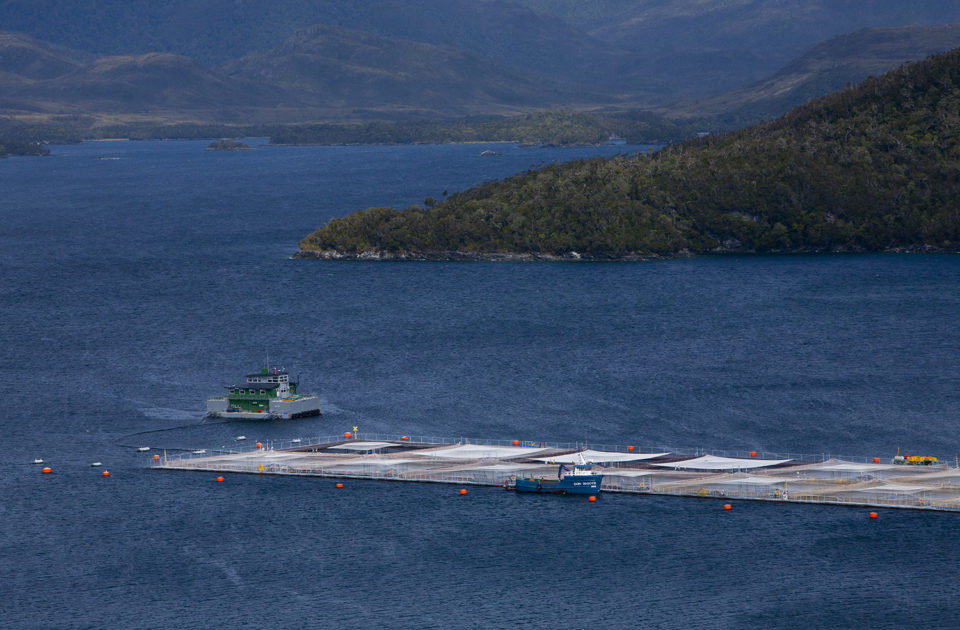Chilean salmon farmers have cut antibiotic usage substantially in three years, but challenges remain in meeting a goal of a 50% reduction by 2025

For Chile’s salmon farming industry, less could be more. That is, less antibiotic use could improve the sustainability of the country’s salmon aquaculture industry and boost the reputation of its products.
An announced goal of cutting usage in half, though, will take multiple innovations applied over many years, according to the Monterey Bay Aquarium, which is helping in the efforts.
“There is an understandable concern for using antibiotics in animal production systems, and aquaculture is not excluded,” Rolando Ibarra, a senior fellow on aquaculture sustainability at the aquarium, told the Advocate.
One issue, he noted, is that antibiotic usage in food production may contribute to rising pathogen resistance. Another concern is the potential impact of antibiotics on beneficial bacteria in sediments and water. And simply, consumer demand for antibiotic-free meats is significant, with a majority reportedly willing to pay more for such products.
Consequently, the aquarium’s Seafood Watch program in conjunction with Chilean producers launched the Chilean Salmon Antibiotic Reduction Program, or CSARP.
“This program involves 95 percent of the companies in Chile, making it the most important private program in reducing the consumption of antibiotics in aquaculture and animal production,” Ibarra said.
According to the 2020 CSARP report, Chile farmed salmon had an antibiotic usage of 412.8 grams per harvested metric ton (MT) in 2017. Usage declined about 30 percent to 293.6 grams per ton in 2019, when the industry nationwide produced 950,000 MT of salmon.
The goal is to cut the 2017 figure in half by 2025, or just over 200 grams per harvested ton. Salmones Blumar is on track to hit the 50 percent antibiotic-usage reduction target, according to Pedro Pablo Laporte, salmon manager for the Puerto Montt, Chile-based seafood producer.
“Environment plays a big role,” he said in discussing how the reduction will happen. “Making progress not only depends on the strategy but also the environment.”
In particular, he pointed to salmonid rickettsial septicemia (SRS), a bacterial disease that is widespread in some Chilean aquaculture regions, and sea lice. SRS is hard enough to control on its own, but the persistent presence of the sea lice makes the job even more difficult.
https://www.aquaculturealliance.org/advocate/oral-vaccine-delivery-effective-in-reducing-salmon-diseases/
An innovation being used to combat SRS is selection of a naturally resistant brood stock, a process that began by identifying which genes are associated with SRS resistance. Armed with that information, suppliers are now concentrating on producing eggs that have the proper gene sequences.
As a result, salmon farmers, Laporte said, have “an extra tool to combat SRS, basically showing a slower rate of infection and a better survival when infected.”
Genetic resistance to disease alone will not be enough to achieve the 2025 goal, he added. Advances in farm and fish management also will play a role.
“Currently, we do not believe there will be a silver bullet for SRS,” observed Alfredo Tello, technical and sustainability manager at Salmones Camanchaca of Santiago, Chile. The salmon producer is on its way to meeting the CSARP 2025 target.
According to Tello, the lack of a single solution to the SRS/sea-lice problem has Salmones Camanchaca following several strategies in addition to disease-resistant broodstock. On the management side, high-performance diets combined with genetic selection for faster growing fish shorten the length of production cycles at sea. This means there is a smaller window for infection to develop and for disease to take hold, which leads to a lower need for antibiotics.
Another avenue for reduction in usage is testing. This can lead to early detection and timely treatment of an infestation, which can cut antibiotic usage while still achieving the desired outcome of healthy fish.
“Delayed antibiotic treatments usually results in a higher use of antibiotics. So, we must detect and treat as early as possible,” Tello said.
He added that in salmon production antibiotics are used to treat specific disease outbreaks, not as a blanket way to promote growth. Communicating that to the public is important, Tello said, along with the fact that salmon farming is one of the most efficient and sustainable animal production systems in the world.
In summing up the salmon production situation in Chile, he said: “Progress is being and will continue to be made in reducing the use of antibiotics.”
Follow the Advocate on Twitter @GAA_Advocate
Now that you've finished reading the article ...
… we hope you’ll consider supporting our mission to document the evolution of the global aquaculture industry and share our vast network of contributors’ expansive knowledge every week.
By becoming a Global Seafood Alliance member, you’re ensuring that all of the pre-competitive work we do through member benefits, resources and events can continue. Individual membership costs just $50 a year. GSA individual and corporate members receive complimentary access to a series of GOAL virtual events beginning in April. Join now.
Not a GSA member? Join us.
Author
-

Hank Hogan
Hank Hogan is a freelance writer based in Reno, Nevada, who covers science and technology. His work has appeared in publications ranging from Boy’s Life to New Scientist.
Tagged With
Related Posts

Innovation & Investment
Net gains in aquaculture net technology
The aquaculture industry is paying greater attention to net technology, in terms of materials and maintenance, because of its impact on the bottom line.

Innovation & Investment
Innovation Award 2020 finalist: Aquaterra from Nuseed
Aquaterra® is the third of three finalists for the Global Aquaculture Alliance’s Annual Global Aquaculture Innovation Award for its omega-3 solution.

Innovation & Investment
Egg sorting technology helps pick fish-growth winners
Automated egg-sorting technology developed by GenetiRate is being tested by prominent aquaculture companies and showing promising results.

Aquafeeds
With byproducts, getting more from – and for – fish
Use of fish trimmings and byproducts in fishmeal and fish oil is a win for aquaculture. But challenges loom, including logistics and economics.

